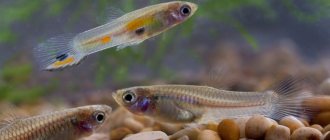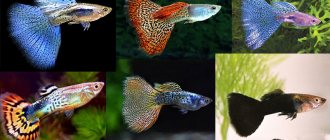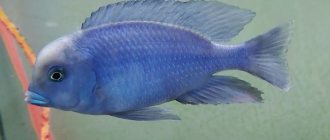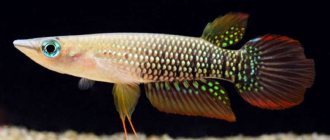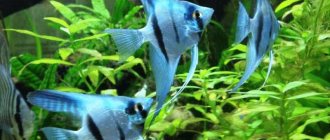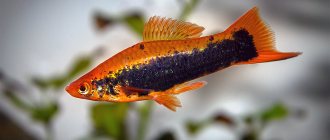Guppies are characterized by great adaptability. At the same time, they also have certain environmental requirements that must be met for their successful breeding. This is especially important for breeding domestic purebred guppies.
However, it does not follow from this that it is necessary to create conditions for them that completely coincide with the optimal conditions of their life in nature: it should be borne in mind that the guppy has long been a pet. As a result of domestication, its heredity, its appearance, and its requirements for living conditions changed to one degree or another. The guppies bred in our aquariums (more precisely, breed groups) are so different from each other and from their wild ancestors that at first glance they can be mistaken for different species. The most attractive features of color and shape of fins are different in different breed groups, and therefore the conditions under which they look most effective are also different. Gray (in terms of background color) guppies are less demanding of living conditions than light-colored ones, and light-colored ones are less demanding than albinos. Large-finned ones are more demanding than short-finned and forked ones. They even reach sexual maturity at different ages. Different aquarists, and even more so in different cities and countries, have guppies adapted to different conditions (feeding, temperature, water hardness, pH, etc.). Therefore, recommendations cannot be made for all groups. When purchasing guppies, it is useful to ask about the conditions in which they lived with their previous owner. Guppies accustomed to frequent water changes or to a flow-through aquarium do not take root well in an aquarium with “old” water and vice versa.
If you want to have good purebred guppies, it is better to keep them not only separately from other fish, but even different breeds of guppies, in different aquariums. To maintain and even obtain offspring from one pair of guppies, it is enough to have a three-liter jar. But to raise offspring obtained from one pair, you need an aquarium with a capacity of at least 20 liters and a length of at least 40 cm.
The lifespan of males at moderate water temperatures is 2.5-3 years, females - 3.5-4, but they stop reproducing a year and a half earlier.
Setting up an aquarium for guppy
Three-liter jars, glasses (according to the Internet) and tiny nano-aquariums should all be considered only a temporary home for guppies. They don’t live in these, but survive, and these, you see, are two big differences. The ideal water level for guppies in an aquarium: 35-40 cm. In the spawning tank, where newly born fry must rise to the surface for air to fill their swim bladder, the desired water level is no more than 20 cm.
Of course, for many aquarists, guppies live in large aquariums with other fish and reproduce without problems. And guppy fry in a community aquarium survive in “crowds”. However, among specialists this is called “self-seeding”. If you are not going to monitor the purity of the breed and breed guppies for breeding purposes, then the size of the aquarium, by and large, is only of relative importance. Please note that self-seeding inevitably leads to the degeneration of the breed - after a few generations, the percentage of defective, infertile and simply plain-looking fish will become too large.
The Indian fern is considered a unique indicator of water quality for guppies. If it is well rooted and growing quickly, everything is normal. As soon as the roots of the plant begin to rot, it floats to the surface and even dies - which means hard times have come for the guppies. The cause of the changed conditions should be found out and eliminated as quickly as possible!
plants for an aquarium with guppies - for purely decorative reasons. Small fish will look more impressive against the backdrop of such flora. But you should not be overzealous with the number of plants. Otherwise, the pH differences between day and night will become too significant, especially if the aquarium is not aerated at all.
By the way, about aeration: in nature, all types of guppies live in slow-flowing and not at all crystal clear reservoirs. Artificially oxygenating water for them is perhaps not entirely correct. Because the closer the conditions of their existence are to natural ones, the better. Only sometimes, if there is overcrowding in the aquarium and it is generally too small for all the fish, do you have to organize both aeration and filtration. When the fish begin to swim near the surface, frantically swallowing air, this is a sure sign that they are suffocating, and it’s time to buy an aerator! In a small (15 to 20 liters) aquarium, where there is no purging, you can keep veiled guppies at the rate of about one and a half liters per male and from two to three liters per female. If the aquarium is aerated, the planting density increases two to three times.
If you have round-tailed breeds, then the stocking density increases by another order of magnitude without the threat of overpopulation. A one hundred liter aquarium with a constantly running aerator and filter (plus regular replacement of some of the water with fresh water) is an excellent home for three hundred males. And in the case when there is no soil in it, and detritus is constantly removed using a siphon, up to four hundred male guppies can be planted in it.
For females intended for breeding, the stocking density is two to three times less. If these norms are violated, the fertile function of fish drops to almost zero, since the maturation and functioning of the sex glands is inhibited.
Eehhh.
. And don’t forget a thermometer with a suction cup for 25 rubles!
And I would advise the person who got the fish by accident to think first, but it is necessary. After all, a simple can is not the case at all. It’s worth buying a jar, even if it’s a small one, equipment, and periodically running around for food. And then, God forbid, they get sick. Another gimor. And then another one will die, and you’ve already become attached to them, it will become a pity.
In my opinion, in general, to engage in aquarium keeping at least at the initial amateur level, you need to be a little sick in the head. After all, you create so many problems for yourself in life.
In short, Sklikhasovsky would give this advice: first think ten times whether all this is necessary, and only then start acting. In the latter case, feel free to go to the market and take all your business.
PS It all starts small.
I completely agree with Samuel! If you want one place of adventure, go to the market and buy an aquarium. I sincerely wish to do just that, because aquarium keeping is a damn exciting and enjoyable activity!
Over time, you won’t be able to drag him away from your favorite aquarium by the ears. And keeping fish in a 3-5 liter jar is an ignoble task, neither for the fish nor for you! Good luck!
I only disagree with one thing
then buy an Aquael heater for 50 watts) - why 50 watts? Is it for 30-40 liters? it will raise the temperature by 10-12 degrees, if not more, and in general it’s good if the temperature in the room is 20 or more; guuppies don’t need heating at all
Lighting, temperature and other tricks
The duration of lighting in an aquarium with guppy should be no more than 12 hours a day. This is very important for the health of the fish. Experiments have shown that the results of continuous lighting can be extremely disastrous. Firstly, the ability to reproduce is reduced. Secondly, the guppy’s color fades. For example, individuals colored in all shades of red become pale pink after only 24 hours of constant light. If you give them a break from exposure to bright lamps, the color will gradually recover. But the fertile function, unfortunately, is not.
It will be just wonderful if the sun's rays sometimes fall on the aquarium. The sun is a natural stimulator of all life processes in any living organism, and fish in this case are no exception. In winter, the duration of lighting is reduced by two to three hours, which also brings the conditions in the aquarium closer to natural ones.
For a 20-liter tank, the light of one 15 W light bulb (fluorescent or regular incandescent lamp) is sufficient. For a 40-liter - 15 W in summer and 25 W in winter. To illuminate a 100-liter aquarium, you need a 40 W lamp.
The location of the lamp is above the aquarium and preferably above its center.
Aquarium plants will be an excellent indicator of the correct lighting level. If they grow well, their stems and leaves are a healthy green (or wine-red) color, then there is no cause for concern. Yellowing, degrading, pale bushes signal a lack of light. Leaves covered with a coating of algae, plus water blooms indicate excessive lighting.
Interesting information about the most popular aquarium fish
So, what is known about the most popular guppy fish:
- Vitality. The fish can survive even in 100 ml of water. But you shouldn’t take this fact as a guide to action. The specimen will begin to lag in growth and quickly become ill.
- Helped fight malaria. Yes, guppies can be called a creature with medicinal properties. In the second half of the 19th century, a malaria epidemic developed in Europe, which raged in all regions. This problem did not exist on the neighboring continent where guppies existed. Interestingly, after the beauties moved to other bodies of water, the problem left the country.
- Helped science. Experiments carried out for the purpose of reproduction and obtaining new breeding forms helped scientists understand the basic laws of heredity.
- Scouts. Of course, this designation is exaggerated, but it was guppies who became the first aquarium fish that managed to travel into space. This happened on board the Salyut 5 orbital station. They successfully survived the journey, and the females also managed to reproduce offspring during this time.
These are the most popular aquarium fish, guppies. What new things did you learn from our article? Write in the comments and ask your questions related to guppies and other aquarium fish - we will be happy to answer them. Don’t forget to share the link to our article with your friends, let them know how exciting aquarium hobby is.
Water temperature for guppy
There is still no consensus among guppy fans about the temperature in a guppy aquarium. One part of aquarists believes that the higher it is (up to 27ºС), the better. Others claim that low temperatures have a more beneficial effect on their pets' bodies. Everyone has quite compelling arguments that make them believe in the correctness of both one and the other opinion.
However, the following recommendations are common and work well: guppies do not feel discomfort at temperatures from 18 to 30ºC. Is that reproduction is more active when the thermometer shows a figure slightly higher than 24ºС. At temperatures below 17ºС, diseases, including infectious ones, begin to appear. In general, the lower temperature limit for guppy: 4ºС. Daily fluctuations of 3-5ºС will not harm them.
less than 50W
very difficult to find. only Chinese non-name, which is generally fast. I came across this when I was looking for a 10L nursery for viviparous fry. In the end, I put in a 50W Jaeger so that my head wouldn’t hurt.
Friends, thank you very much for your answers.
I must admit, I am touched by your concern. In this three-liter jar there are two males (purple), two females (gray) and two babies. It’s difficult to estimate the size - I can’t run after them with a ruler, but about 3-4 cm. I take the water from large canisters - do you think it’s possible to do without settling? There is no point in buying an aquarium for work, but at home my family is categorically against it. I didn’t expect to be so impressed by these kids and firmly decided that I would definitely have a huge aquarium with beautiful fish in my new apartment. In the meantime, the question is how not to kill these people. And the question is, they swim and gasp for air - is this normal for fish or do they urgently need a compressor?
Changing water in a guppy aquarium
Regarding water changes when keeping guppies in an aquarium, we need to speak out specifically. It is usually recommended to do them weekly. This is possible, but if you pour the entire required volume into the aquarium at once (up to 50% of the aquarium’s capacity), then sooner or later you will kill your fish. Therefore, fresh water is added gradually, a small portion every day, distributing the entire volume equally between the seven days of the week. Or they reduce the number of changes, making them once a month, but also in parts. Or they add the entire volume at once, but bringing the parameters of fresh water to complete identity with the parameters of the water in the aquarium.
The fact is that sudden changes in the chemical composition (primarily pH) and water temperature have an extremely negative effect on guppies. Females become infertile as a result. Males have split fins - sometimes only at the edges, sometimes tearing along. Meanwhile, staying in old water reduces fish resistance to diseases. Therefore, it is impossible to completely abandon substitutions.
A small and little-known secret: adding iodine tincture and sea salt solution to the aquarium has a very positive effect on the development and strengthens the immunity of fish. Try adding no more than one or two teaspoons of sea salt for every 10 liters of water. It is best to purchase it at a pet store. But if you wish (and are able to get all the necessary components), you can limit yourself to this mixture: magnesium chloride, magnesium sulfite and sodium chloride in a ratio of 5:7:28. Iodine is also suitable in a 5% alcohol solution. You need 2-3 drops for every 20-30 liters of water.
It means so.
Please advise me something, thanks in advance. I really don't want to kill them.
You should purchase a heater and filter. If you don’t want to spend money, and this is exactly the concept I’m describing, then buy a 50-watt Aquael heater and a micro or mini Aquael filter. Micro is a little cheaper, but mini, I think, is preferable. The whole thing costs around 1000 rubles. you will launch. But this is the next topic.
[Modified 4/28/2004 by Engineer]
How much is a few? Size? About 8 adults will survive with a weekly change of 0.5 liters. In the beginning, replace 2-3 rubles per week
0.3 l. Don’t forget to let the water sit, preferably three days, although in an emergency for goops one is enough. Be more careful with feeding - it is better to underfeed than to overfeed and spoil the water.
Engineer's message: A heater and filter should be purchased. If you don’t want to spend money, and this is exactly the concept I’m describing, then buy a 50-watt Aquael heater and a micro or mini Aquael filter. Micro is a little cheaper, but mini, I think, is preferable. The whole thing costs around 1000 rubles. you will launch. But this is the next topic.
And I want to tell everyone a little secret!
When the Engineer was 8 years old, there was also a three-liter jar of gupeshkas on his table, there were pebbles piled in it, and there was also a sprig of elodea floating there. His parents didn’t help him, so he had no knowledge of the aquatic field at all, he poured tap water into the jar, the heater was a battery, don’t even ask about the filter. And then the boy grew up and now wants a 500-liter aquarium (for my poor head). And now, bye everyone, I’m crawling under the table, because they’re going to kill me now.
[Modified 4/28/2004 by Engineer's Wife]
not allergic to fish
and on the stern. The aquarium humidifies the air, which is useful. And you can only be allergic to fish if you have one.
Before the holidays, change half the water, they will survive 4 days. what to buy:
1) an aquarium, preferably a square one 2) a thermometer (either a suction cup or an LCD glued to the glass) 3) a filter 4) soil 5) if the aquarium is without a lid with a built-in light, then you will need to come up with some kind of light. for grass and fish look better in the light. office desk lamp is quite suitable
